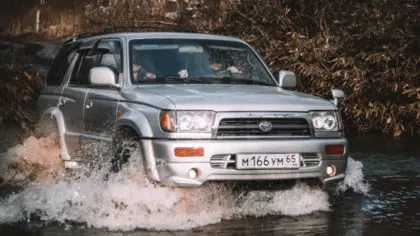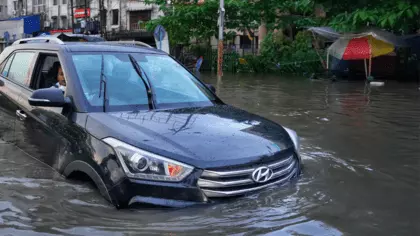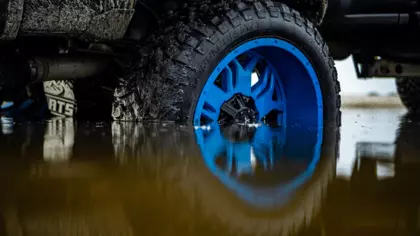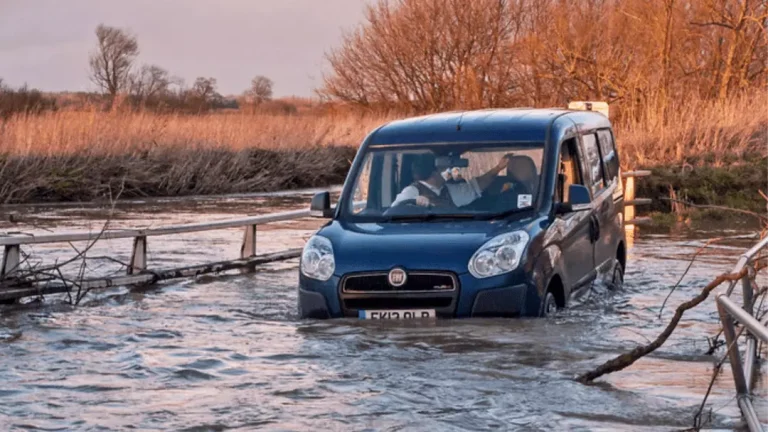A car stalled in water now won’t start just clicks can happen due to plenty of reasons, including hydro lock, voltage drop, or engine damage. But worse things can occur due to your silly mistake.
So instead of doing any stupid things, you must understand why this happens, what to do in this situation, and what to do if the car stops suddenly while driving through the water. read on to learn this information to fix the issue quickly avoiding damaging the car engine.
Car Stalled in Water Now Won’t Start Just Clicks

Leaving a car stalled in water is dangerous, but something you can’t do anything about due to the heavy flood. But after the floodwaters have run away, if you notice the car won’t start just click, following are some potential reasons:
Hydro Lock
The most potential reason for hearing the clock noise of a car stalled in water is the hydro-locked engine. Water may draw into the engine’s air intake, soak the air filter, and eventually enter the engine if the car is left stalled.
Car engines compress the mixture of fuel and air during running. But the engine can’t compress water, hence it doesn’t rotate anymore. So when the ignition switch tends to turn on, the starter motor can’t turn the engine on. Hence, the starter solenoid produces a loud click instead of starting the vehicle.
Solution
If you didn’t try to start the car repeatedly or if the engine stalled before attaching the bent rod, it’ll be simple to fix. To solve the problem, remove the spark plug and wash out the water from the engine cylinders. Then change the fluids, dry the wet carpet, and change some electric parts. Your car’s engine should start now.
Voltage Drop
The engine should have at least 12 volts out of the 14 bolts in the system. In a stalled car, the wire can also be stalled. Water is beneficial, despite its unpredictability and conductivity. As a result, 12 bolts that fail the start sequences can be leeched out. As a result, the solenoid may just produce a click noise rather than towing and engaging.
Solution
Pull the car out of the water and turn the ignition or battery off. Allow the component to completely dry before applying current to it. Once it is dry, connect a hot battery and turn it on. It should work.
Battery Dead After Driving Through Water
A car stalled in the water now won’t start and just clicks due to a dead battery, which is a misconception. Though floods can hurt the car’s internal components, they shouldn’t damage the battery. The reason is that most car batteries are waterproof. They are sealed intentionally to keep water away.
So, if your car stalled in shallow water, the water should not affect the battery. Instead, you should worry about other components after leaving the car stalled in water or driving through a flood. The components that can get damaged due to water are:
- Transmission
- Brake pads
- Engine
- Suspension
- Electrical sensors
However, the battery of the electric vehicle can get damaged due to water. A modern electric car like Chevy Volt and Tesla placed their battery under the cabin. Though a flood can’t damage the engine of the electric vehicle, it can hurt the electrical parts around the battery badly.
How to Restart a Car after Stalling in Water

Are you excited to restart the car that has stalled on the flooded street? We have bad news for you. You might not be able to restart your car anymore. The worst result of a car stalling in water or driving through deep water is that water can enter the cylinder via the air intake.
When attempting to start the engine, the cylinder will enter the compression stroke, but the water will not compress. As a result, the pressure in the cylinder may skyrocket and end up breaking down. It can also hurt the head gasket, the top of the piston, or the spark plug, and the worst result is damaging the whole engine.
What If a Car Stalled in Water now won’t start Just Clicks?
Instead of trying to start the car, the safest possible attempts you can make are:
Take the car to an auto repair shop or a place where you can work on it. Then remove the filter, all the spark plugs, and the intake ducting. Check the cylinder and intake for water. After that, check the oil level and make sure there is no water.
You can use a dipstick to check the fluid’s condition. If they look discolored, diluted, or milky, it means the oil has become contaminated and needs to be changed, and you can do it yourself as well.
Then remove the camshaft sensor wire to prevent causing a fire. Crank the motor over to remove water from the cylinder efficiently, and spray the cylinder with fogging oil so rust cannot form in the cylinder.
Reattach the spark plug without installing the camshaft sensor and crank. Listen for the click sound. If it doesn’t produce the wired sound, plug in the camshaft sensor and turn on the motor. But if you still listen to the clicking noise, the engine may shoot, and the piston or connecting rod might not compress water and stop the motor. In this case, let an expert mechanic handle the job.
How Long Does it Take for a Car Engine to Dry Out?
Typically, the engine should dry up quickly; however, electric and electronic components can take on water if submerged. Lots of factors also determine the amount of time it will take to dry out a stalled car engine, including the type of engine, whether it is injected or carbureted, and the reason causing the engine to flood.
In general, an older vehicle with a manual choke can be flooded by the choke over-engaging. The carbureted car includes a floating sink because of corrosion or a pinhole, which can also flood the engine.
Conversely, many modern injected engines come with a diaphragm-type fuel regulator, which can leak and cause the engine to flood.
You can dry most flooded carbureted engines simply by cranking them and keeping the throttle fully open. However, you must make sure that dumping raw gasoline won’t cause any major issues.
You can’t apply this trick to an injected engine. Instead, shut off its key, press down the throttle, and hold it for around 5 minutes. Then let the pedal go up and spin the key to crank. You should be able to start the engine.
What to Do If the Car Stops in the Water

The step you should take in this annoying situation depends on the depth of the water and the type of water as well.
Depth of the Water
If the water level is so high that it may enter the air intake or breather, your car is stuck. It means you have to tow it.
But if the water is only one or two feet high, your car should start. To get out of it, try driving slowly at first. If you can’t, it means the car is stuck.
Type of the Water
Another consideration is the type of water. If your car stops in shallow water and it has a manual transmission, you’ll get a second chance. Once again, try to drive slowly and carefully. If the car doesn’t start and you only need to go a short distance, you can get the car out of this hassle.
However, it’s a bit challenging, and you can only do it once to avoid damaging the start.
The secret is to put the vehicle in first gear and let the clutch out. Turn on the key to start the car and hold the key until the car is out of the water. Luckily, the starter is quite strong and can lurch the car forward in first gear for a short distance, particularly in shallow water. But you can’t keep trying this trick. Otherwise, it can damage your starter.
But if it isn’t shallow water, don’t try to turn on the engine. Instead, pray everything remains okay and tow the car to a shop. If there is a chance that a person can start the engine, tell him not to do so as the engine may have water. You should also inform the tow truck driver so that he can transport them safely to the auto shop.
Potential Consequences
If you are lucky enough, the water should only flood the intake and prevent airflow. In this case, trying to start the engine can let the water enter the engine and break something. The reason is that the engine is designed to compress air, while water isn’t compressible. So it won’t hurt you much if you don’t try to start the engine.
But if the water has already passed the throttle, it can block the piston or head, which are expensive to replace. Another concerning issue is an electrical problem after driving through water. The water can damage the wire and electrical parts completely and may hurt your wallet badly. After taking it to the shop, the mechanic should remove the intake and spark plug.
Then he should inspect the engine to see if water exists inside it. He should change the water, dry every part, and try to start the engine to take further steps based on the result.
FAQs
1. Can water prevent the car from starting?
If you drive your car through deep water, you can refuse to start even if the battery remains okay. The reason is that the starter can get damaged due to driving through if the battery remains okay. The reason is that the starter can get damaged due to driving through water, as a wet starter cannot start the engine.
3. How to flush water out of an engine?
Start with removing the lower radiator hose. Hold the coolant in a container that will come out after removing the hose. Then remove the top radiator hose and flush out the system using a standard hose. Keep doing this until water runs out of the engine’s bottom. Once done, refill with coolant and attach both of the radiator hoses.
4. What if your BMW won’t start after driving through water?
Firstly, get your BMW out of the water, disconnect the battery, and dry the car out completely. Recharge the battery and reconnect with the car. If the engine starts, it’s done. Otherwise, take the car to the nearest auto shop.
Final Words
After understanding why your car stalled in water won’t start just clicks, you now should be able to take the safest step. No matter how long your car has stalled, don’t dare try to start it to avoid causing severe damage. Instead, tow the car first and take it to the auto shop. If you have skill with an automobile, inspect the car’s interior and diagnose any possible damage.


